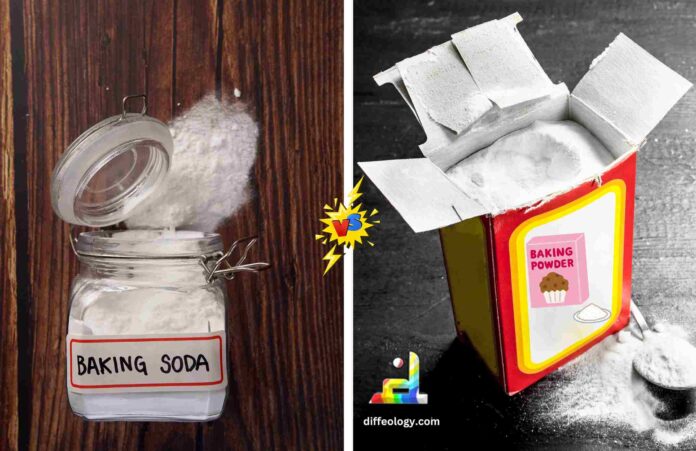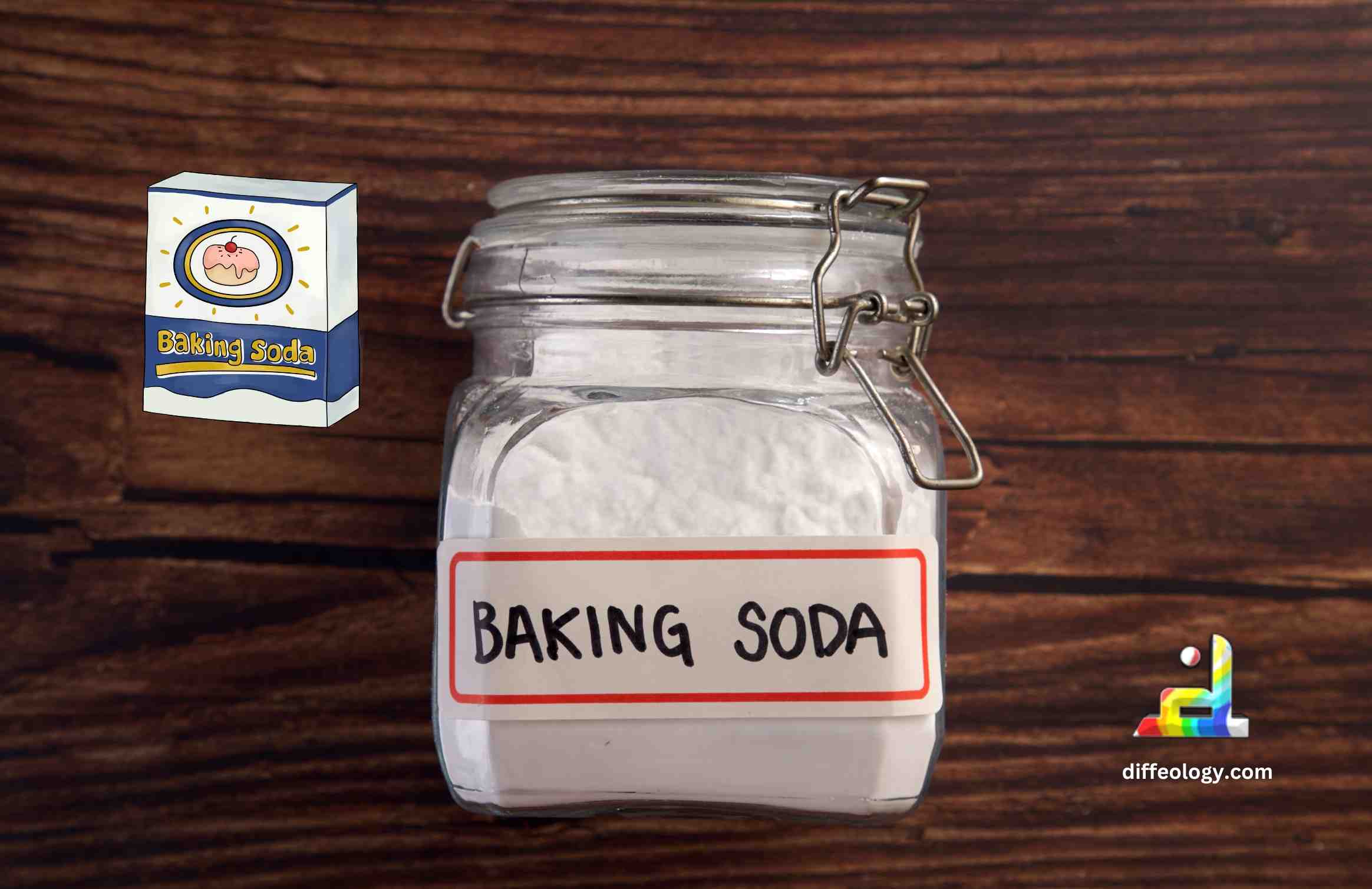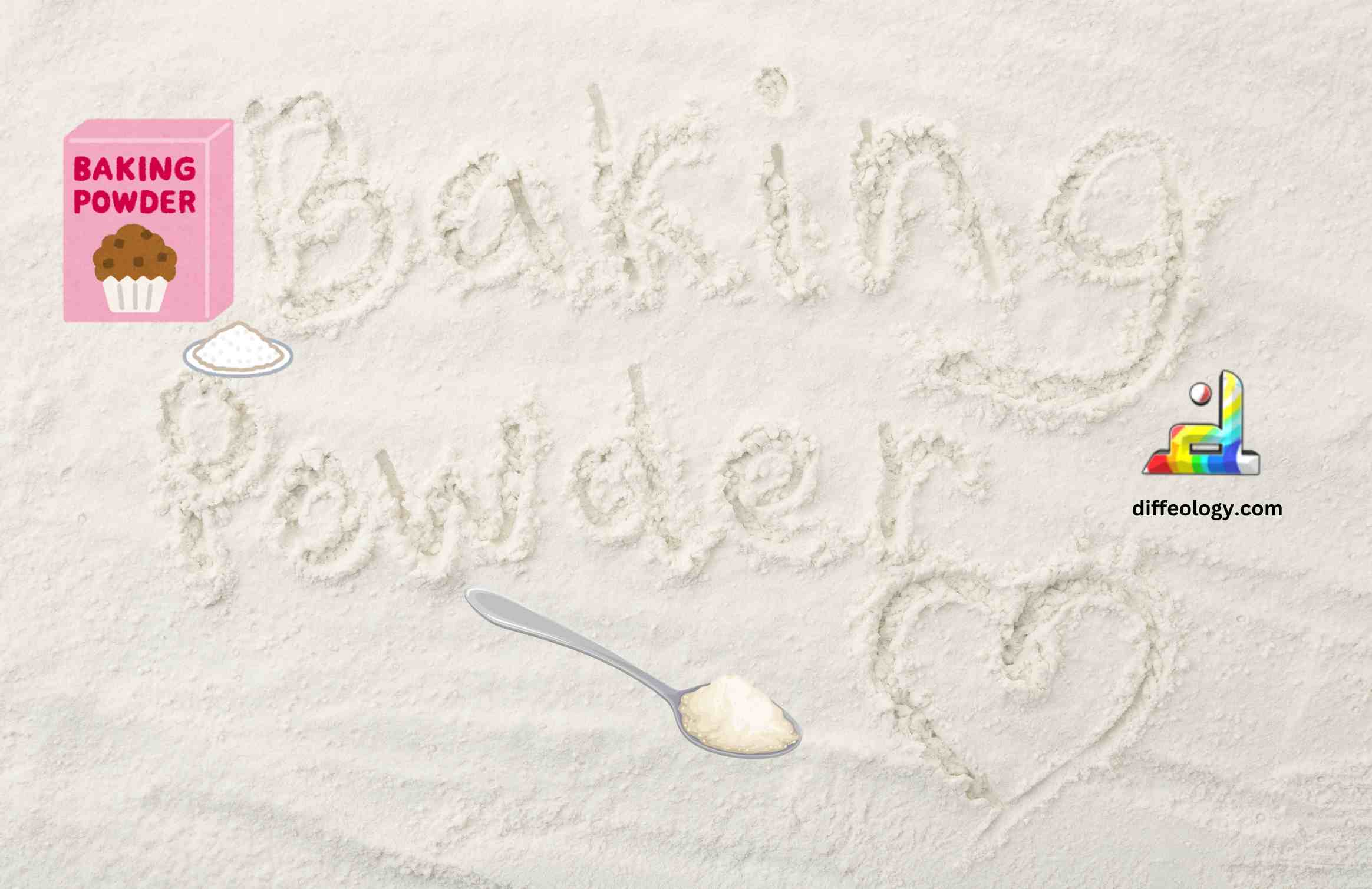When baking cookies, cakes, or muffins, you might come across two common ingredients: baking soda and baking powder. Both are used to help baked goods rise and become light and fluffy, but there is a Difference Between Baking Soda and Baking Powder. Baking soda, also known as sodium bicarbonate, is a basic compound that needs an acid (like lemon juice or vinegar) to activate it and make your dough rise.
Baking powder, on the other hand, contains baking soda along with an acid, so it just needs moisture and heat to start working. Knowing the difference between these two leavening agents is important because using them incorrectly can lead to flat, dense baked goods. This understanding can help you make better recipes and achieve perfect results in the kitchen.
Main Difference Between Baking Soda and Baking Powder
Baking soda is pure sodium bicarbonate. Baking powder contains sodium bicarbonate and an acidifying agent (like cream of tartar) plus a drying agent (like cornstarch). Baking soda is a single-acting leavening agent. Baking powder is a double-acting leavening agent, meaning it acts twice—once when wet and again when heated. Baking soda needs an acid (like lemon juice or vinegar) to activate. Baking powder already has acid in it, so it doesn’t need an additional acid to work. Baking soda can leave a bitter taste if not enough acid is present. Baking powder is neutral and doesn’t affect the taste of the food.
Baking Soda Vs. Baking Powder
What is Baking Soda?
Baking soda, also known as sodium bicarbonate, is a white, crystalline powder that’s commonly used in baking. It acts as a leavening agent, which means it helps baked goods like cakes and cookies rise by producing carbon dioxide gas when it reacts with an acid, like vinegar or lemon juice. This reaction creates bubbles that make the dough or batter expand, giving your treats a light and fluffy texture. Baking soda is a basic compound with a pH of around 8.3, which is slightly alkaline. This property not only helps in baking but also makes it useful in neutralizing acids and odors, which is why you might find it in household cleaning products or even in toothpaste.
Read Also: Difference Between Soda Water and Sparkling Water
Beyond baking, baking soda has a wide range of uses. For example, it’s often used in fire extinguishers to help put out small grease fires. It’s also a popular home remedy for heartburn or indigestion because it can neutralize stomach acid. Interestingly, just one teaspoon of baking soda contains about 1,200 milligrams of sodium, so it’s something to use in moderation, especially if you’re watching your sodium intake. In addition, baking soda is environmentally friendly and non-toxic, making it a safer alternative to many chemical cleaners. Its versatility and effectiveness make it a staple in kitchens and households around the world.
What is Baking Powder?
Baking powder is a common ingredient used in baking to help make cakes, cookies, and other baked goods rise. It’s a dry chemical leavening agent that consists of a combination of an acid (usually cream of tartar), a base (like baking soda), and a filler (often cornstarch) to keep the mixture dry. When baking powder is mixed with liquid, the acid and base react, producing carbon dioxide gas. This gas forms bubbles in the batter, causing it to expand and rise. Without baking powder or a similar leavening agent, baked goods would be dense and flat. For example, one teaspoon of baking powder can produce enough gas to increase the volume of the batter by about 50%.
Read Also: Difference Between Baking And Broiling
There are two types of baking powder: single-acting and double-acting. Single-acting baking powder releases all its gas when it gets wet, so you need to bake the batter immediately after mixing. Double-acting baking powder, which is more common, releases some gas when mixed with liquid and the rest when exposed to heat in the oven. This type of baking powder is more forgiving, giving you a bit more time before the batter must be baked. In most recipes, you’ll find that about one teaspoon of baking powder is used per cup of flour, ensuring the right amount of rise and fluffiness.
Comparison Table “Baking Soda Vs. Baking Powder”
| Type | Single ingredient | Combo of ingredients |
| Components | Sodium bicarbonate | Sodium bicarbonate + acid |
| Acid | Needs added acid | Already contains acid |
| Reaction | Reacts when wet and heated | Reacts twice: wet and heated |
| Taste | Bitter if too much | Neutral taste |
| Use | Acidic recipes (e.g., vinegar) | Non-acidic recipes |
| Leavening Power | Strong, quick action | Gentler, sustained action |
| Common Use | Cookies, quick breads | Cakes, muffins |
| Shelf Life | Long, if kept dry | Shorter, reacts over time |
| Activation | Needs liquid + acid to activate | Needs liquid only |
| Substitute | Needs an acid to replace | Substitute with careful measurement |
| Quantity Needed | Small amount | Larger amount than soda |
| Side Effects | Can be too strong, causing overflow | More controlled rise |
| Mixing | Mix with dry ingredients | Mix with dry ingredients |
| Storage | Keep in an airtight container | Keep in an airtight container |
| Common Pairing | Vinegar, lemon juice | Milk, water |
| Origin | Pure chemical | Mixed chemical |
Difference Between Baking Soda and Baking Powder in Detail
Get to know the Difference Between Baking Soda Vs. Baking Powder in Detail.
1. Chemical Composition: What’s Inside?
Baking soda and baking powder are both leavening agents, but their chemical makeups are different. Baking soda is pure sodium bicarbonate, a simple chemical compound that needs an acid and a liquid to activate. When these two things mix, they produce carbon dioxide gas, which causes the dough to rise.
On the other hand, baking powder is a bit more complex. It contains sodium bicarbonate like baking soda but also includes an acid, usually cream of tartar, and a drying agent, often cornstarch. Because baking powder already has the acid it needs to react, it only requires moisture to start working, making it more versatile for baking.
2. How They Work in Recipes
Baking soda requires an acid to activate. This acid can come from ingredients like lemon juice, yogurt, or vinegar. When mixed with these acidic ingredients, baking soda releases carbon dioxide bubbles, which help the dough or batter rise. However, if there’s no acid in the recipe, baking soda won’t work, and your baked goods might end up flat.
Baking powder, however, works in two stages. The first reaction happens when it gets wet—this is when the initial bubbles form. The second reaction occurs when the batter is heated in the oven. This two-stage process helps ensure that baked goods rise well and have a nice, fluffy texture, even if there’s no acidic ingredient in the recipe.
3. Taste Impact: Flavor Differences
Baking soda has a strong, somewhat bitter taste, which is why recipes that use it usually include an acidic ingredient to neutralize its flavor. If too much baking soda is used or if it’s not properly neutralized, it can leave a soapy or metallic taste in the final product, which is unpleasant.
Baking powder, because it contains both an acid and a base, is more neutral in flavor. This means it won’t affect the taste of the baked goods as much as baking soda might. However, using too much baking powder can sometimes lead to a slightly bitter aftertaste, especially in recipes that don’t balance it out well.
4. Usage: When to Use Which?
Baking soda is best used in recipes where an acidic ingredient is already present, such as in chocolate cakes, banana bread, or buttermilk pancakes. It’s a strong leavening agent, so a little goes a long way. Typically, you’ll see recipes calling for just a small amount of baking soda.
Baking powder, on the other hand, is often used in recipes that don’t have any acidic ingredients. It’s common in recipes for cakes, cookies, and quick breads where a lighter, more airy texture is desired. Since it has a balanced chemical composition, you can use it in larger amounts without worrying too much about the flavor.
5. Shelf Life: How Long Do They Last?
Baking soda has a long shelf life, usually lasting up to two years if stored properly in a cool, dry place. However, once opened, it should be used within six months to a year for best results. To test if your baking soda is still active, you can mix a little with vinegar—if it bubbles vigorously, it’s still good to use.
Baking powder has a shorter shelf life due to its added ingredients. Unopened, it can last for about 18 months. Once opened, it should be used within six months to ensure its effectiveness. You can test baking powder by mixing it with warm water—if it bubbles, it’s still active.
6. Reactions to Heat and Moisture
Baking soda reacts immediately when it comes into contact with both an acid and a liquid. This means you need to bake the batter quickly after mixing; otherwise, the carbon dioxide bubbles will escape, and your baked goods might not rise properly.
Baking powder, especially the double-acting type, reacts in two stages. The first reaction occurs when it’s mixed with a liquid, and the second happens when it’s exposed to heat in the oven. This delayed reaction gives you more baking flexibility since you don’t have to rush to get your batter into the oven right away.
7. Substituting One for the Other: Is It Possible?
While baking soda and baking powder are not interchangeable, there are ways to substitute one for the other in a pinch. If you only have baking soda but need baking powder, you can make your own by mixing 1 part baking soda with 2 parts cream of tartar and 1 part cornstarch.
If you only have baking powder but the recipe calls for baking soda, you can use about three times the amount of baking powder, but this might affect the flavor and texture of your baked goods. It’s usually better to follow the recipe as written to get the best results.
Key Points Describing the Difference Between Baking Soda and Baking Powder
- Reaction Speed: Baking soda reacts immediately when mixed with an acid. Baking powder reacts in two stages: when wet and when exposed to heat.
- Shelf Life: Baking soda has a longer shelf life if stored properly. Baking powder has a shorter shelf life because it can lose its potency over time.
- Uses in Recipes: Baking soda is often used in recipes with acidic ingredients like buttermilk. Baking powder is used in recipes without acidic components.
- Amount Needed: Baking soda is stronger, so less is needed in recipes. Baking powder is weaker, so you usually need more of it.
- Color of Baked Goods: Baking soda can cause baked goods to brown more. Baking powder doesn’t have much effect on browning.
- Storage: Baking soda should be stored in a sealed container to keep it dry. Baking powder should also be stored tightly sealed to avoid moisture.
- pH Level: Baking soda is alkaline (basic) in nature. Baking powder is neutral, as it contains both an acid and a base.
- Cleaning Uses: Baking soda is commonly used for cleaning because of its alkaline nature. Baking powder isn’t used for cleaning.
- Substitution: Baking soda cannot be substituted for baking powder directly. If substituting, you must add an acid to baking soda.
- Foam and Texture: Baking soda creates a coarse texture with large bubbles. Baking powder gives a finer texture with smaller, consistent bubbles.
- Common Pairings: Baking soda pairs well with acidic ingredients like yogurt. Baking powder is often used in cakes and muffins.
- Packaging: Baking soda is usually sold in a small box or bag. Baking powder is sold in a canister to protect it from moisture.
- Environmental Impact: Baking soda is eco-friendly and often used in green cleaning products. Baking powder doesn’t have specific environmental uses.
FAQs: Baking Soda Vs. Baking Powder
Conclusion:
While both baking soda and baking powder help make baked goods rise, they do so in different ways. Baking soda needs an acid to work, whereas baking powder already has an acid included. For most recipes, using the right leavening agent is key to getting the texture you want. Incorrectly substituting one for the other can lead to disappointing results, such as overly dense or bitter-tasting treats. By understanding the Difference Between Baking Soda and Baking Powder and knowing when to use each one, you can improve your baking skills and ensure that your homemade cakes, cookies, and breads turn out just the way you want them.
References & External Links
- The History of Baking Powder
- Baking Soda Uses, Health Benefits, Side Effects, and More



